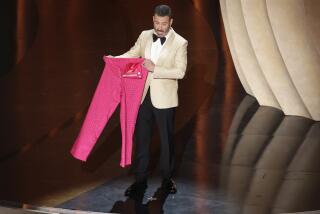Fate Pens Fairy-Tale Ending for Actress and Stolen Oscar
The Oscar statuette, bearing a price tag of $100, caught Steve Neimand’s eye at a Pasadena flea market because two men were arguing about whether it was real.
Two years later, Neimand, a collector of baseball memorabilia, saw the same Oscar for sale at a swap meet in another part of Pasadena. This time, the price had reached $500. And this time Neimand, in cahoots with a friend, forked over the cash.
“I couldn’t believe it when I saw it again,” said Neimand, 42, a Santa Clarita lawyer. “It sounds corny and hokey, but sometimes you wonder if it was meant to be.”
Collectors like Neimand so love the memorabilia they track down that it takes on a life of its own. They rarely expect to collide with the historical characters themselves.
This time would be different.
The Oscar, about one-half the size of a typical one and featuring an unusual round base, had been awarded 50 years ago to child star Margaret O’Brien, who played little Tootie in “Meet Me in St. Louis.” It had been stolen--by a maid, O’Brien believed--when the actress was 17.
O’Brien began moving toward that Oscar when she was 4 years old in 1941 with a one-minute appearance in “Babes on Broadway.” She was quickly hailed as a child star who could charm audiences and turn her emotions on and off like faucets. (“When I cry, do you want the tears to run all the way or shall I stop halfway down?” a 6-year-old O’Brien asked director Vincente Minnelli.)
On Oscar night, 1945, 7-year-old Margaret heard her name called by her idol, Bob Hope, and dashed to the stage, where she clutched her Special Oscar for the most outstanding child actress of 1944, an award presented only intermittently.
Hope lifted her to the microphone so she could be heard by the radio audience and asked his squirming charge: “Will you hurry and grow up, please?”
With her Oscar in her hands, the little girl renowned for her poise and spunk forgot the carefully memorized speech that her mother had crafted in anticipation of triumph. “Thank you,” she said. “I really don’t know what to say.”
At the O’Brien home on Beverly Drive, Margaret’s awards were kept in a special room. When her mother was sick with a heart condition, the maid took the Oscar and two other awards to her home to polish, as she had done in the past. When the maid did not return to work, she was fired.
The elder O’Brien died without discovering that the maid had not returned the awards. Months later, Margaret, 17, started phoning the maid but could not reach her. The phone was eventually disconnected.
In the years that followed, O’Brien dreamed she might one day recover her Oscar. She enjoyed antique shopping, and “every time I’d go to an antique shop or flea market, I’d look around. I’d tell myself, ‘If I don’t lose hope, it’ll come around.’ ”
It did. But O’Brien wasn’t there.
*
Steve Neimand had a collector friend and friendly rival named Mark Nash, an assistant manager of an air-conditioning parts store who lives in Long Beach. Nash, 44, liked to arrive at swap meets at 5:30 a.m. Armed with a flashlight, he would check out the wares in the darkness. This way he could beat Neimand to the best baseball stuff.
To finance purchases, the men occasionally bought items and resold them at a profit. Nash had bought 500 stadium chairs dating back to the ‘60s from Foulton County Stadium in Atlanta, Ga., selling them for $225 apiece.
But at the Pasadena City College flea market in December, neither Nash nor Neimand were having much luck. As usual, they cruised the tables separately and met up to compare notes.
To Nash and Neimand, a good find would be a baseball bat or a trophy from the ‘20s or ‘30s, or perhaps some old team photos. Or, improbably, a uniform once worn by Babe Ruth or Lou Gehrig. “To me,” said Neimand, who plays in an adult softball league and owns Dodgers season tickets, “ that would be the Holy Grail.”
Instead, on this day, Neimand spotted the small Oscar. He looked closer and realized it was the same one he had seen two years earlier. Once again, he walked away. When he met up with Nash a few minutes later, the two commiserated with each other over the slim pickings. Neimand told his buddy about the Oscar that kept bouncing into his life, an award with Margaret O’Brien’s name inscribed upon it.
“To be honest, I thought she was the little girl in ‘Miracle on 34th Street,’ ” said Neimand, referring to a role played by Natalie Wood. “I don’t know that I have ever seen any of the films Margaret O’Brien was in.”
Nash had never heard of O’Brien. Nevertheless, figuring that an Oscar might be resold for big money, he urged his friend to buy it, offering to split the $500 cost. The two had not walked far with the Oscar when they bumped into another friend, a photographer. The three began talking about an upcoming memorabilia auction. Deciding to sell the Oscar there, Neimand and Nash loaned it to the photographer to shoot for the auction catalogue. Auction officials told them they would make at least $10,000.
Several weeks later, Bruce Davis, executive director of the Academy of Motion Picture Arts and Sciences, which runs the Oscar ceremonies, was sitting at his desk when a friend called to tell him that an Oscar bearing O’Brien’s name was scheduled to be sold at an auction.
Davis checked his records. Academy officials had supplied O’Brien with a replacement Oscar not long after they learned that the original had been stolen, and Davis figured that the replacement was up for sale. He was astonished to learn that the auction was offering the original.
Of the 2,113 Oscars awarded in the last 66 ceremonies, one dozen have been lost or stolen. There is a hot market for them. When Vivien Leigh’s family sold her Oscar for “Gone With the Wind” in 1993, it fetched $563,500, the highest price ever paid for an Oscar.
In an effort to reduce the number of Oscars in public circulation, award winners since 1950 have been asked to sign an agreement that prohibits them or their heirs from selling the coveted trophy.
Cases of missing Oscars have been difficult to crack. O’Brien, however, got lucky.
Davis contacted a casting director friend of his and O’Brien’s. The casting director phoned O’Brien and told her the Oscar had been found.
O’Brien first thought the call might be a prank. “I was just amazed,” she said. “It means a lot more now than it did when it was lost. I had kept thinking about it. I always kept up hope.”
Then the casting director called the auction on O’Brien’s behalf and asked for the Oscar. Nash and Neimand got the word, and without hesitation agreed to return it to O’Brien.
“Almost like fate,” Neimand said.
Despite receiving no reward, he had only one request: “Can I get a picture of me handing the Oscar to O’Brien so I can tell friends I once presented an Academy Award?”
A meeting was quickly arranged so O’Brien could tell the story of her loss to Nash and Neimand. Then, last month, the academy held a news conference for the trio. Amid the hot lights of television cameras, O’Brien once again received her Oscar. To thank Nash and Neimand for their generosity the academy gave each man two tickets to this year’s ceremonies.
Finding a quiet moment, O’Brien pulled the two men aside. If they ever happened across the white nightgown she wore during her jaunty cakewalk dance or the white Victorian hat she donned on her way to the fair in “Meet Me in St. Louis,” would they be so good as to give her a call?
Today, the Oscar sits in a locked antique display case in O’Brien’s den in her Sherman Oaks home.
“I’ll never,” O’Brien said, “give it to anyone to polish again.”
More to Read
Only good movies
Get the Indie Focus newsletter, Mark Olsen's weekly guide to the world of cinema.
You may occasionally receive promotional content from the Los Angeles Times.










